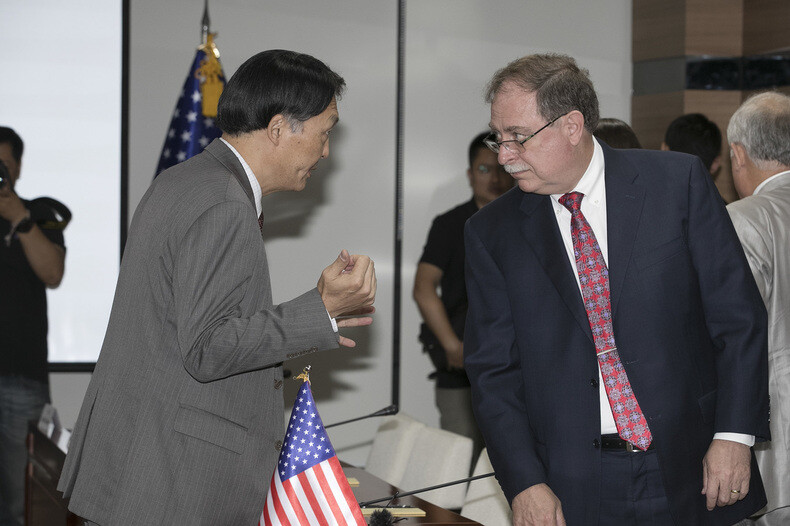hankyoreh
Links to other country sites 다른 나라 사이트 링크
[Editorial] 8.2% increase in S. Korea’s defense contribution due to US’ take-no-prisoners approach

The South Korean and US officials negotiating an update to the two countries’ defense cost-sharing agreement have reportedly agreed that Seoul’s contribution this year will be 1.04 trillion won (US$925.4 billion), up 8.2% from last year, and are planning to initial the agreement on Feb. 10. Considering that US President Donald Trump was personally pressuring the South to shoulder a larger share of the cost of stationing US troops on the Korean Peninsula, it’s a relief that an agreement was reached before the North Korea-US summit scheduled for Feb. 27-28, which is set to be a turning point in Korean Peninsula affairs. Even so, the amount of the increase is disappointing, as well as the fact that it only applies for one year.
It’s impossible not to express deep regret for the US’ take-no-prisoners approach to the negotiations. Trump has taken every opportunity to trumpet his claim that US allies like South Korea are getting a free ride for security while pressuring Seoul to increase its contribution. He even created instability in South Korea by provoking conservatives’ “security insecurity” by hinting at the possibility of scaling back the US troop presence in the country. Important as US national interest may be, a longtime ally ought to be shown a modicum of trust and respect, which was a far cry from the attitude adopted by the US in these negotiations. If the US exploits its asymmetric relationship with its allies for its own economic interest, it reduces the “reciprocal relationship” to mere rhetoric and undermines trust between allies.
The 8.2% increase in South Korea’s defense contribution is on an unprecedented scale in recent years. That scale becomes even clearer when we consider that last year’s rate of inflation was 1.5%. The government points out that this figure coincides with the 8.2% rate of increase in this year’s defense budget, but the scale of the increase can’t be papered over with such quibbling. South Korea was already giving ample support to the US troop presence. According to figures released by the Korea Institute for Defense Analyses (KIDA) in May 2018, the total support South Korea provides to US Forces Korea (USFK) – including not only its defense contribution but also access to land and facilities and various tax breaks and exemptions – added up to more than 5 trillion won (US$4.45 billion) in 2015 alone. That’s why South Korean negotiators don’t deserve a good grade, even when the Trump administration’s extreme selfishness is taken into account.
The agreement’s period of validity was also shortened to a single year, as the US wanted, rather than the three to five years that South Korea requested. Considering that the negotiations that are finally winding down were supposed to have been over last year, the negotiations for next year’s cost-sharing agreement will have to start up again in a few months. There’s no doubt that the US will ask for another increase in the cost.
While Seoul claims that the one-year period of validity is a one-off special arrangement that won’t happen again, it remains to be seen whether that’s actually the case. The fact is that, as long as Korean Peninsula affairs are in flux, South Korea is unlikely to gain an advantage in its cost-sharing negotiations with the US. Regardless, the government needs to do a better job with its preparations and, at the very least, increase the agreement’s period of validity to three to five years.
Please direct comments or questions to [english@hani.co.kr]

Editorial・opinion
![[Column] The state is back — but is it in business? [Column] The state is back — but is it in business?](https://flexible.img.hani.co.kr/flexible/normal/500/300/imgdb/original/2024/0506/8217149564092725.jpg) [Column] The state is back — but is it in business?
[Column] The state is back — but is it in business?![[Column] Life on our Trisolaris [Column] Life on our Trisolaris](https://flexible.img.hani.co.kr/flexible/normal/500/300/imgdb/original/2024/0505/4817148682278544.jpg) [Column] Life on our Trisolaris
[Column] Life on our Trisolaris- [Editorial] Penalties for airing allegations against Korea’s first lady endanger free press
- [Editorial] Yoon must halt procurement of SM-3 interceptor missiles
- [Guest essay] Maybe Korea’s rapid population decline is an opportunity, not a crisis
- [Column] Can Yoon steer diplomacy with Russia, China back on track?
- [Column] Season 2 of special prosecutor probe may be coming to Korea soon
- [Column] Park Geun-hye déjà vu in Yoon Suk-yeol
- [Editorial] New weight of N. Korea’s nuclear threats makes dialogue all the more urgent
- [Guest essay] The real reason Korea’s new right wants to dub Rhee a founding father
Most viewed articles
- 1[Column] Why Korea’s hard right is fated to lose
- 2Amid US-China clash, Korea must remember its failures in the 19th century, advises scholar
- 3[Column] The state is back — but is it in business?
- 4[Column] Life on our Trisolaris
- 5AI is catching up with humans at a ‘shocking’ rate
- 6[Guest essay] Maybe Korea’s rapid population decline is an opportunity, not a crisis
- 760% of young Koreans see no need to have kids after marriage
- 8[Column] Can Yoon steer diplomacy with Russia, China back on track?
- 9[Editorial] Yoon must halt procurement of SM-3 interceptor missiles
- 10[Reporter’s notebook] In Min’s world, she’s the artist — and NewJeans is her art